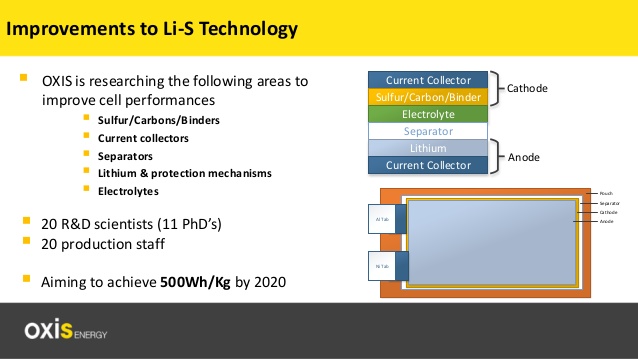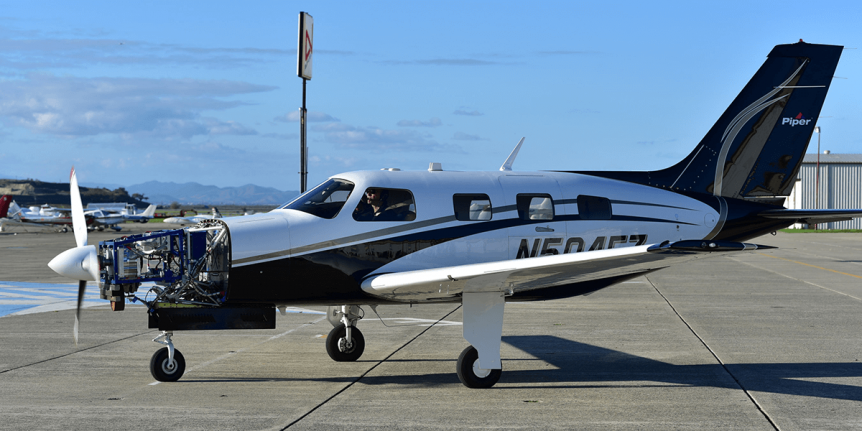While we wait yet another five years for commercial development of each newly announced but promising battery chemistry, one company has its cells ready to fly in Bye Aerospace’s eFlyer 2 and in Texas Aircraft’s Colt S-LSA. Oxis Energy has managed to leapfrog lithium-ion makers with its lithium-sulfur battery packs packing 400 Watt-hours per kilogram. Considering the best announced pack-level li-ion performance has been 260 W-hr/kg, the leap is significant. Batteries, for now, are at the heart of electric aircraft. Until Doc Brown’s Flux Capacitor or a hydrogen fuel cell with Dollar Tree refills comes along, batteries are battling it out for our airborne dollars. Lithium-ion remains in the forefront, with Tesla staging its shareholders’ meeting and its long-anticipated “Battery Day” on September 22. Elon Musk has been dangling the promise of a million-mile battery for the last year, which may tie in with Chinese manufacturer Contemporary Amperex Technology (CATL). According to Bloomberg, CATL’s, “Chairman and founder Zeng Yuqun said …
ZeroAvia Counts on Hydrogen
Tucked away in the quiet little airport at Hollister, California, ZeroAvia has stealthily been developing a hydrogen-powered Piper Malibu, and flying it for the last six months. It sounds like a regular aircraft taking off and passing overhead, even with its two 130 kilowatt (174.26 horsepower) electric motors. ZeroAvia claims 275 kW (369 hp) for the pair. From the videos, propeller noise seems to be much the same as a conventional, internal-combustion powered Malibu, but lacks the added noise of the engine. Piper M-series aircraft are normally powered by a Teledyne Continental Motors TSIO-520BE engine rated at 310 hp (230 kW). Valery Miftakhov, ZeroAvia’s founder and CEO announced, “Right now we have an aircraft that’s six seats and 2 tons as an R&D demonstrator. Next year we’ll have a 20-seat aircraft and we’ll submit the design for [Federal Aviation Administration (FAA)] certification. That’s what drives the 2022, 2023 timeline. At that point, we’re expecting to have certification and put the …
Zipline Drones Use Modularity, Simplicity to Deliver Healthcare
Fortune magazine headlined its article about Zipline drones with this teaser: “The Trick to Achieving Universal Health Care? Drones.” The article quotes Zipline International CEO Keller Rinaudo concerning the logistics of today’s health care systems, which “really only serve the ‘golden billion’ people on the planet.” Fortune adds, “Millions more die from lack of care.” Rinaudo spoke to Fortune’s Brainstorm Health Conference in San Diego, and explained how his Silicon Valley technology delivers 60-percent of Rwanda’s national blood supply – by drone. About half of the blood goes to mothers suffering from postpartum hemorrhaging. With excellent results in Rwanda, Zipline will set up four distribution centers in Ghana, starting on April 24. These centers will serve about 20 million people. Fortune explains, “For Rinaudo, drones are a way for a nation to access universal health care almost overnight. Call it a golden idea.” Time is Worth More than Money in the Medical World Evan Ackerman and Michael Koziol report in the IEEE …
Two New and Unique Energy Storage Solutions
Lithium-ion and lithium-polymer batteries of various brands provide energy for Teslas, Leafs, and Bolts, but continue to disappoint by stalled energy density, power density, and safety concerns. Two relative newcomers to the field might have answers to these concerns. Unlike many other newcomers, production might be less than five years away. Enovix Corp. Ken Rentmeester, a good friend and retired chemical engineer, volunteers in the local TeenFlight program run by Dick VanGrunsven. He shared his copy of the IEEE Spectrum containing an article about a new battery company that may have some answers to problems common to lithium batteries. The company’s claims for their Enovix battery are impressive. “Patented 3D cell architecture, a patented 100% silicon anode, photolithography, and wafer production increases energy density and eliminates thermal runaway.” Making thermal runaway go away would make the Enovix battery a much desired energy source, especially for electric aircraft. A recent fatal collision of a Tesla Model X with two other cars …
George Bye is a Busy Electrical Entrepreneur
George Bye, with his namesake company, Bye Aerospace, is involved in projects ranging from solar-powered drones to 345 mph VTOL cross-country cruisers. Following the Money People are betting on the plausible success of George’s SunFlyer 2, built by subsidiary Aero Electric Aircraft Corp. (AEAC), and he’s received deposits on 105 of the two-seat training craft. Due for release in the next two years, one prototype nears test flights this year. As its capabilities are demonstrated, Spartan College of Aeronautics and Technology might increase its initial reservation for 25 SunFlyers. Think of the impact this will have on flight training schools when SunFlyers and Alpha Electros begin delivering new pilots. George did a great job of extolling the virtues of electric aviation in an online IEEE Spectrum article, “Cheaper, Lighter, Quieter: The Electrification of Flight Is at Hand.”* He notes that the airplane will be certified in the “standard-category, day-night visual flight rules” category, “with a target gross weight of less than …
From DARPA Ugly to Svelte and Streamlined
Seeing Google cars navigating our streets and highways, with their arrays of spinning sensors and antennas bristling from their roofs gives us the impression that the technology involved is complex and expensive. Until recently, they were, with Wired reporting that early Google cars had multiple $80,000 LIDAR systems, and entrants in DARPA (Defense Advanced Research Projects Agency) challenges often sported over a quarter-million in esoteric devices that could, on occasion, spot the Holy Spirit in the vicinity. (Your editor made that last part up.) Mike Ramsey, writing for the Wall Street Journal suggests those prices may be going down – way down. “A Silicon Valley startup says it has solved several of the issues that might plague the introduction of autonomous vehicles — primarily the cost of the equipment. “Quanergy Systems Inc., of Sunnyvale, Calif., says it will offer a light detection and ranging sensor — or LIDAR — next year that costs only $250 and is the size of …
Titan Aerospace and Its Low-Flying Satellites
Ken Rentmeester, a regular reader of the blog, shared a news item from the IEEE (Institute of Electrical and Electronics Engineers) Spectrum. Calling Titan Aerospace’s Solara unmanned aircraft “atmospheric satellites,” the article gives a brief history of solar-powered craft, including the Boucher brothers’ Sunrise I, the first solar-powered airplane in 1974, Paul MacCready Jr.’s first piloted solar-powered flight in 1980, and the current world’s endurance record for unmanned, solar-powered flight by the QinetiQ Zephry in 2010. That airplane follows the look of the Boucher’s early effort, and Titan’s examples look a great deal like scaled-up versions of FAI F5-type models which rely on electric self-launching, rapid climbs and extreme flight capabilities to win contests. Despite great successes such as Zephyr’s, there so far has been no commercial market for this type of aircraft. Titan hopes to overcome shortcomings that prevented broader acceptance for its predecessors. These included limited photovoltaic capabilities, poor battery endurance, and fragile airframes, which were simply scaled-up …
Unzipped Nanotubes Show Energetic Promise
Rice University, supported by the Air Force Office of Scientific Research (AFOSR), has demonstrated “a way to boost the efficiency of the ubiquitous lithium ion (LI) battery by employing ribbons of graphene that start as carbon nanotubes.” The AFOSR explains, “Four years ago, [Rice chemist James] Tour’s research team demonstrated that they could chemically unzip cylindrical shaped carbon nanotubes into soluble graphene nanoribbons (GNR) without compromising the electronic properties of the graphitic structure. A recent paper by the Tour team, published in IEEE Spectrum and partially funded by AFOSR, showed that GNR can significantly increase the storage capacity of lithium ion (Li-ion) by combining graphene nanoribbons with tin oxide. “By producing GNR in bulk, a necessary requirement for making this a viable process, the Tour team mixes GNR and 10 nanometer wide particles of tin oxide to create a slurry. GNRs, a single atom thick and thousands of times longer than they are wide, not only separate and support the …






